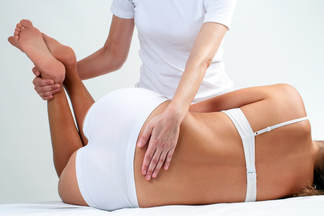MET - Muscle Energy Technique

Mobilisation without manipulation!
In addition to the application of remedial massage techniques, MET (Muscle Energy Techniques) may be used to correct any pelvis or spinal dysfunctions. Muscle Energy Technique is a manual therapy technique which uses a muscle’s own energy in the form of gentle isometric contractions to relax the muscles via autogenic or reciprocal inhibition, and lengthen the muscle. MET is a much gentler approach than the High Velocity, Low Amperage thrust manipulations applied by Chiropractors or manipulative physiotherapists.
The technique requires the patient to apply a small counted-strain against the force of the therapist. The therapist holds the patient in such a position that the dysfunctioning vertebra, or pelvic misalignment is just starting to take up load, but is not yet being asked to move. At this point the counter-strain by the patient is applied, and since the muscles can't actually contract, the offending joint moves back into correct position. READ MORE HERE
As compared to static stretching which is a passive technique in which therapist does all the work, MET it is an active technique in which patient is also an active participant. MET is based on the concepts of Autogenic Inhibition and Reciprocal Inhibition. If a sub-maximal contraction of the muscle is followed by stretching of the same muscle it is known as Autogenic Inhibition MET, and if a submaximal contraction of a muscle is followed by stretching of the opposite muscle than this is known as Reciprocal Inhibition MET" [1]
This is a better/simpler explanation I feel > "Muscle energy technique (or MET) is based on the principle of reciprocal inhibition, a theory that explains that muscles on one side of a joint will always relax to accommodate the contraction of muscles on the other side of that joint when indirect pressure is applied. MET is often applied to patients who suffer from muscle spasms.[2]"
In addition to the application of remedial massage techniques, MET (Muscle Energy Techniques) may be used to correct any pelvis or spinal dysfunctions. Muscle Energy Technique is a manual therapy technique which uses a muscle’s own energy in the form of gentle isometric contractions to relax the muscles via autogenic or reciprocal inhibition, and lengthen the muscle. MET is a much gentler approach than the High Velocity, Low Amperage thrust manipulations applied by Chiropractors or manipulative physiotherapists.
The technique requires the patient to apply a small counted-strain against the force of the therapist. The therapist holds the patient in such a position that the dysfunctioning vertebra, or pelvic misalignment is just starting to take up load, but is not yet being asked to move. At this point the counter-strain by the patient is applied, and since the muscles can't actually contract, the offending joint moves back into correct position. READ MORE HERE
As compared to static stretching which is a passive technique in which therapist does all the work, MET it is an active technique in which patient is also an active participant. MET is based on the concepts of Autogenic Inhibition and Reciprocal Inhibition. If a sub-maximal contraction of the muscle is followed by stretching of the same muscle it is known as Autogenic Inhibition MET, and if a submaximal contraction of a muscle is followed by stretching of the opposite muscle than this is known as Reciprocal Inhibition MET" [1]
This is a better/simpler explanation I feel > "Muscle energy technique (or MET) is based on the principle of reciprocal inhibition, a theory that explains that muscles on one side of a joint will always relax to accommodate the contraction of muscles on the other side of that joint when indirect pressure is applied. MET is often applied to patients who suffer from muscle spasms.[2]"

On a personal note, I feel the authors in [1] and [2] are describing Post Isometric relaxation, in association with reciprocal innervation; and yes, those two techniques are involved in MET. However, there is more to it than that! For example, if you are suffering from a sacral torsion/twist, Muscle Energy is a technique where you are placed in the correct position for that particular complaint, and you are held still by the therapist as you apply gentle counter-strain [isometric contraction] against the therapist. In that instance you would be placed in the position similar to that illustrated by the image on the left.
Now here is where the skill and experience of the therapist is required; i.e. you in fact do the stretches described above - but when held in exactly the correct position and you apply the counter strain, since you can not move, the misaligned bone moves. Very subtle, but in conjunction with Trigger point therapy, dry needling, myofascial release [whatever the muscles require] the body is now realigned and pain relief should be certain. If you complaint is Sacroiliac dysfunction, you may be placed in the position similar to the image above.
Now here is where the skill and experience of the therapist is required; i.e. you in fact do the stretches described above - but when held in exactly the correct position and you apply the counter strain, since you can not move, the misaligned bone moves. Very subtle, but in conjunction with Trigger point therapy, dry needling, myofascial release [whatever the muscles require] the body is now realigned and pain relief should be certain. If you complaint is Sacroiliac dysfunction, you may be placed in the position similar to the image above.
